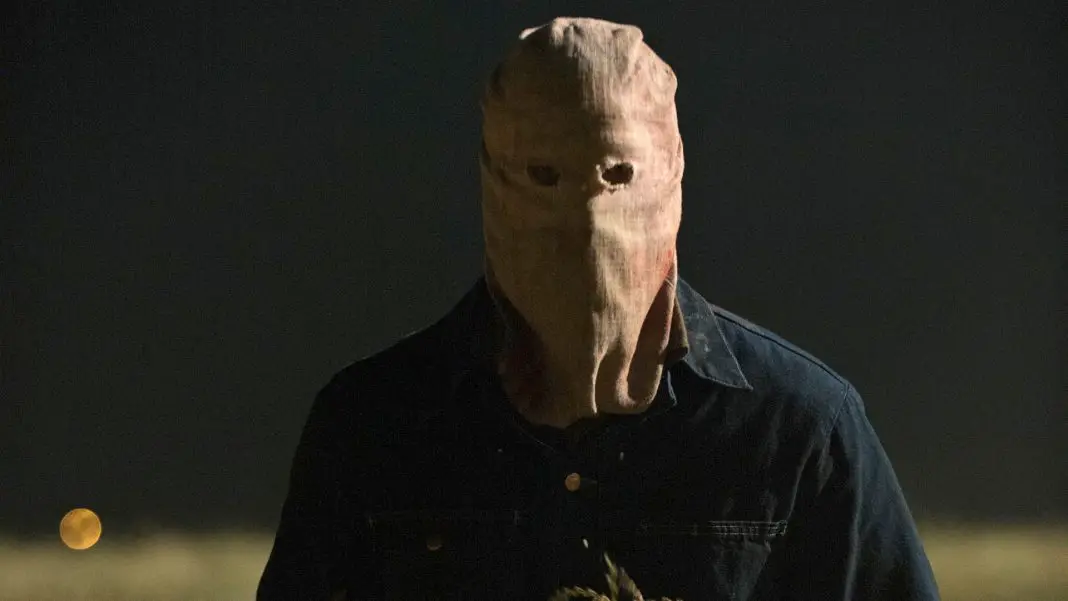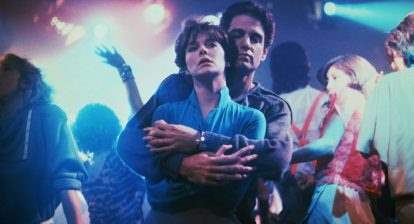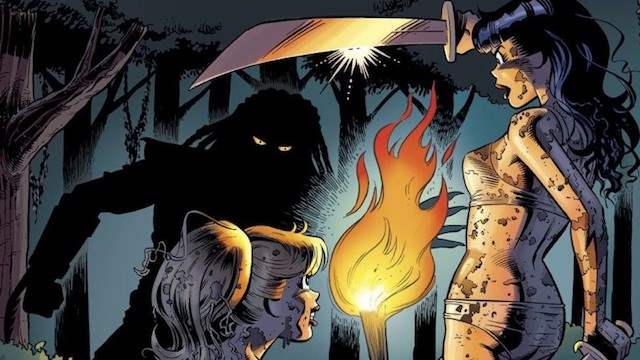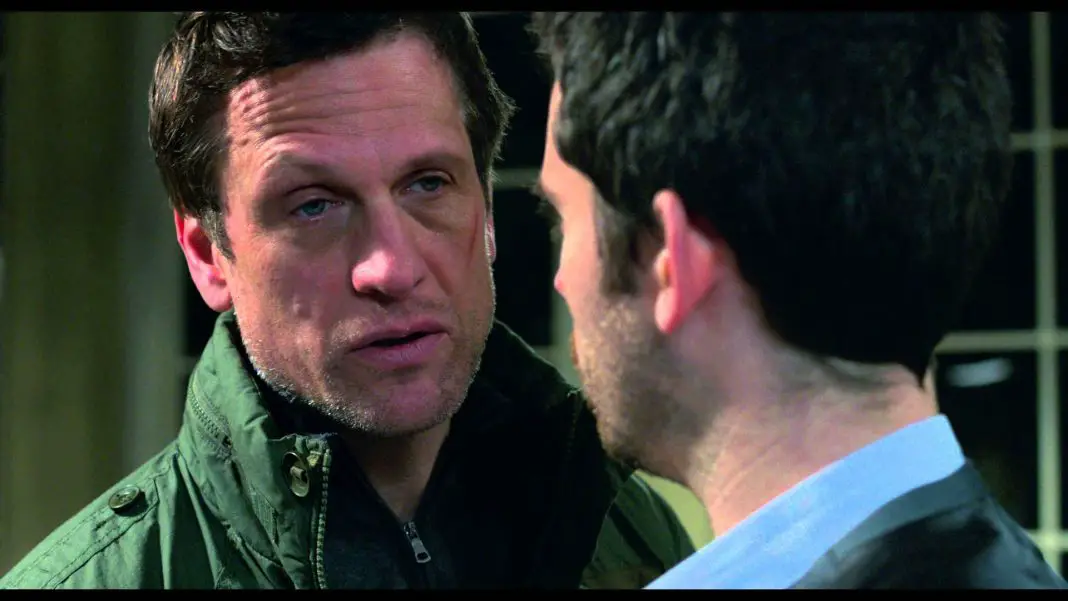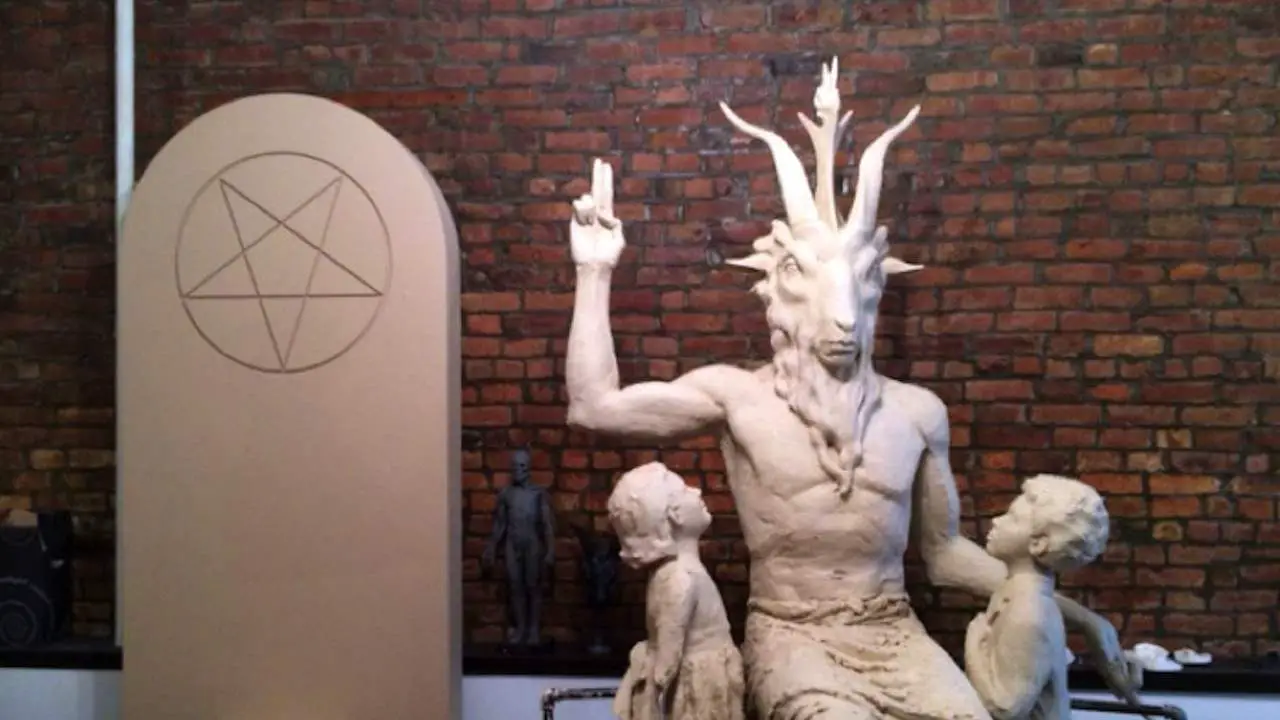Is The Town That Dreaded Sundown based on a true story? Well, yes. But with some creative listen taken. Keep reading for the full rundown on the Texarkana Phantom and the feature film adaptation based on the harrowing murders.
The Cold Case That Would Eventually Inspire The Town That Dreaded Sundown
The cold case of the Texarkana Phantom is a story unlike any other. This masked killer terrorized a small Southern city over a six month period in 1946. He claimed five casualties and heavily traumatized three others while simultaneously throwing an entire town into hysterics. The Texarkana Phantom’s attacks (which later inspired the classic horror movie The Town That Dreaded Sundown) transpired between February 1946 and July 1946. They left five dead, three injured, and an entire town traumatized.
Details seen in this piece have been verified by the books: The Phantom Killer: Unlocking the Mystery of the Texarkana Serial Murders: The Story of a Town in Terror by James Presley (the nephew of Bill Presley, the local Sheriff presiding over the case) and The Texarkana Moonlight Murders: The Unsolved Case of the 1946 Phantom Killer by Michael Newton.
The First Attack on the Town of Texarkana is Followed by a Series of Murders Loosely Reenacted in The Town That Dreaded Sundown
On February 22nd, 1946, Sheriff Bill Presley received a late night call that a young couple was attacked on an unpaved road, known as Lover’s Lane. Texarkana, the border town straddling Texas and Arkansas, was having a typically quiet night for law enforcement, so Sheriff Presley and three patrolmen went out to investigate the site of the alleged attack.
The officers tried to interview the victims (Jimmy Hollis and Mary Jeanne Larey) at the scene, but Hollis’s injuries were so sever he struggled to retain consciousness. Sheriff Presley sent them to Texarkana Hospital while he and the other officers investigated the scene. They combed through the area surrounding the road, finding nothing except for an abandoned pair of pants which later turned out to belong to Hollis. The officers then took statements from the victims about the bizarre event. They did not realize the journey that they, Texarkana, and the nation were about to embark upon.
Jimmy Hollis and Mary Jeanne Larey were a young couple in the process of divorcing other people. While Hollis received emergency surgery for a severe skull injury, Larey spoke to officers. Hollis spoke with police after waking from a coma. Some of the testimony was unhelpful since the pair provided conflicting descriptions of the suspect. Both agreed the person who attacked them was tall, approximately six feet, and male. But they disagreed on the suspect’s race. Hollis claimed he was a young white. But Larey was certain that the suspect was Black. They agreed the suspect wore a mask over his face resembling a pillow case with holes cut out for the eyes and mouth.

A Stranger With a Flashlight
Mary Jeanne Larey and her boyfriend, James Hollis, wanted to end their date night with some private time. After catching a film at a popular theater, they parked on a secluded road known as Lover’s Lane. Sometime during the evening, a stranger’s flashlight blinded the couple.
They assumed it was a police officer making his nightly rounds, but instead an armed, masked man with a flashlight and a gun confronted them. He told the couple to get out the car and they followed the stranger’s instructions, believing that if they did, he wouldn’t kill them. Larey promised the attacker that Hollis did not have any cash on him and even opened his wallet for proof, but the suspect kept on telling her she was lying. After the assailant ordered them out of the car, he told Hollis to take off his pants, but after he did, the Phantom bashed Hollis in the head with the butt of his gun, causing two deep fractures in Hollis’ skull.
The Killer in the Real-Life Case That Inspired The Town that Dreaded Sundown Behaves Mysteriously, Giving Contradictory Commands
After Hollis collapsed from his injuries, the stranger told Larey to run. Once she got some distance from him, he caught up and asked why she ran. She said she ran because he told her to. He called her a liar, punched her in the face, and penetrated her vaginally with his gun. He probably would have killed Larey, but headlights appeared in the distance, which scared him off. Before he escaped into the night, The Phantom punched Larey in the face one last time.
The sheriff assumed the attack was conducted by Larey’s estranged husband, but the ex-lover provided an alibi proving he was nowhere near the crime scene. Also, the police initially did not believe the victims, and thought they were hiding the identity of the gunman. But evidence corroborated their story.
For one, authorities located Hollis’ pants about 100 yards from the crime scene, which suggests his attacker told him to abandon his garments. Also, although Larey was not properly examined for rape at the hospital, there were signs of vaginal bruising reported.
Despite this, little was done to find the suspect. The sheriff did not want to strain the already fragile town and create further racial tension on Larey’s unfounded claims. A few days prior to February 22nd, someone lynched an innocent Black man. This stirred the town. The sheriff believed that the attack on Larey and Hollis was a part of the normal criminal activity in Texarkana. Or even an isolated event. Accordingly, the police department did not believe an active, involved search of the suspect was necessary.

The Violence in the Case That Inspired The Town That Dreaded Sundown Continues in March 1946
Thirty days after Larey and Hollis’ attack, a father and son discovered two bodies in a car parked on a quiet street. As soon as they saw the blood in the car and the bodies of a young couple slumped in the seats, they phoned the police. When first responders arrived to process the scene, the emergency vehicles attracted attention from nearby citizens. Soon after, police appeared and a relatively large crowd formed.
Unfortunately, Sheriff Presley and the Texarkana police department didn’t have training in evidence collection, the crime scene didn’t receive proper processing, and mishandling destroyed all collected evidence.
Also, one spectator lingered dangerously close to the parked car and found the keys about 100 yards away and picked them up with his bare hands. This is one of the many blunders in this investigation.
No Crowd Control
At the horrifying scene, the police were unable to control the crowd that gathered from interfering. Despite this, some evidence found at the scene came in handy. The killer shot both victims in the back of the head with a .32 caliber gun. They were identified as Richard Griffin and Polly Ann Moore when law enforcement officers found the female’s class ring with their high school name and her initials.
Authorities found Griffin on his knees behind the front seat, his pants at his ankles with the pockets turned out and his head resting on his hands, as if asleep. Police found Moore face down in the backseat, her purse opened as if the perpetrator sifted through it. Additionally, there was much blood outside the vehicle, which suggests both Griffin and Moore were outside of their car at their time of death.

Sheriff Presley called on the help of the Texas Rangers in order to identify the type of gun used in the murder from the casings that were left at the scene. Although the Rangers did not have specific educational requirements, they trained in the latest crime scene tech, which included analyzing ballistics and fingerprints.
They had access to a crime lab in Austin for evidence collected at the crime scene. Jimmy Greer was the first Texas Ranger to arrive in Texarkana. His first action was to scold the local police department for shoddy police work. However, when he did send the bullets extracted from Griffin to the Texas Ranger lab, techs confirmed the killer used a .32 automatic pistol.
While Hollis and Larey’s attack quickly left the minds of Texarkana residents, the murders of Griffin and Moore shocked the town and incited a thorough, but initially fruitless, investigation–fruitless until beyond the killer’s next attack, that is.
In April of 1946, Police Respond to More Violent Deaths and Evidence in the Real-Life Crime Spree That Inspired The Town That Dreaded Sundown. Authorities Believe the Deaths are Connected.
Bessie Brown’s motherly intuition woke her up, on the morning of April 14th, 1946, with a start. Her daughter from her first marriage, her beloved Betty Jo Booker, dit not return from her Saturday night gig playing saxophone at the VFW. Nor had she left the instrument behind, which would usually indicate she would be staying with friends.
After her husband, and Booker’s stepfather, Clark Brown, dismissed Bessie’s anxiety as exaggeration, Bessie insisted Clark start making calls to locate her daughter. Clark humored her and called Janann Gleason, the friend with whom Betty Jo was supposed to be staying that night. The phone call gave legitimacy to Bessie’s suspicions, but also alarmed Clark when he learned that Betty Jo never made it to the slumber party. Further to this, no one heard from her all night.
That same morning, fellow residents of Texarkana found the crumpled body of a young man on the side of North Park Road at 6 a.m. Mortified, the family did not leave their car, but instead drove to the closest home to the crime scene, where the residents called the authorities.

Sheriff Presley and the Chief of Police of the Texas side of Texarkana received the call and were the first to respond to the scene. Presley arrived to a gruesome scene of a collapsed body which was reportedly lying on its left side, his head and the trunk of his body on the leaves and grass. His feet and legs jutted onto the dirt road. He was wearing a light-colored long-sleeved shirt, with his arms and hands in front of him. The Town that Dreaded Sundown chronicles these real-life events.
The Third Attack in the Real-Life Murders That Inspired The Town the Dreaded Sundown
At the scene of the third Phantom attack, Sheriff Presley identified the body as Paul Martin from the ID in his wallet. Martin was shot four times; in the back of the neck, the shoulder, his right hand, and one final bullet in his face. Trails of blood crossing the street indicated that after Martin was shot, he had crawled across the unpaved road before finally succumbing to his injuries.
Presley quickly realized he needed more help. Later that morning he placed a formal request to the resident FBI agent in Texarkana to help process the crime scene. While processing the scene and putting the pieces together, word of mouth spread like wildfire. Soon, Sheriff Presley and the rest of law enforcement learned Paul Martin was the last person seen with Betty Jo Booker.
After securing the scene, Sheriff Presley recruited Texarkana residents to search for Betty Jo Booker. Bessie and Chris Brown’s fears were realized when Betty Jo’s body was found 1.75 miles away from Martin’s corpse. The killer shot Betty Jo twice, once in the chest and once in the face. Later examination suggests the murderer had faced her when he shot her at point blank range.

At the scene, there were .32 caliber shell casings near Martin’s car, the same used in Griffin and Moore’s murders the previous month. The FBI also listed that they found six cartridge cases and four projectiles, which had markings that matched the weapon used to kill Griffin and Moore.
When the FBI examined Booker’s body on April 20th, she tested positive for semen and her vagina had marked bruising which might be from penile penetration or penetration with a pistol grip. However, Martin’s genitalia tested negative for seminal fluid, So the two probably did not have sex.
In May 1946, a Horrifying Home Invasion Unfolds in the True Story That Inspired The Town that Dreaded Sundown
On May 3rd 1946, Virgil Starks, a 37-year-old farmer, and his wife of fourteen years, Kate (36), were settling down for the night after a long day. Katie was in bed, waiting for her husband when a clatter arose her suspicions. Convinced that Virgil had dropped something and broken it, Katie left the bedroom to attend to her husband, but found Virgil slumped dead in his armchair, blood seeping down his neck.
Katie judged the killer shot Virgil from the outside of their living room window based on the holes in the glass. The killer stood about 18-22 inches from the window where he could clearly see the back of Virgil’s head. The killer shot Virgil twice in the back of the head and once in the lower back, which short-circuited the heating pad.
His wife immediately ran to the telephone, but before she could use it the assailant fired two more shots, both entering her face. One of the rounds ripped through the skin beside her nose and exited by her ear while the other entered her lower jaw. Both bullets tearing through her teeth, the bullet to the front of her lower law had actually lodged itself under her tongue.
The Attacker is Breaking Down the Door!
Still in shock, Katie dropped to the floor to avoid any more bullets and then fled to the bedroom to search for the firearm that Virgil kept there. However, before she could arm herself, she realized her attacker was breaking down the back door to come after her inside the house. Katie gathered her courage and miraculously was able to run out of the front door to a neighbor who took her to the hospital.
When officers entered the Starks’ home, they found Virgil’s slumped over body, the smoke of the short-circuited heating pad, and numerous bloody handprints all over the furniture and the walls. The killer had dipped his hands in Virgil’s blood and made a vile scene.
The officers immediately secured the house in order to prevent contamination. However, the officers that arrived a short time later contaminated the premises. They preserved the crime scene on the inside, the outside was trampled, making tracking the killer far more difficult.
Police preserved a few key pieces of evidence. A set of latent fingerprints were lifted from inside the house. Additionally, police discovered a size 10 shoe outside the window. Last, they found a red flashlight where the Phantom stood.

Law enforcement attributed this attack to the Phantom. But there were doubts if this was really the work of the elusive serial killer. For one, the M.O. changed from attacking couples on Lover’s Lane to brazenly attacking people in their home. Also, the Starks did not fit into the Phantom’s usual victims. They were married, older, and well established. Furthermore, Virgil was shot with rounds from a .22 rifle, not a .32 caliber handgun.
In June of 1946, Auto Theft is on the Rise
While the Phantom was busy terrorizing Texarkana, a string of auto thefts transpired. Thereafter the stolen vehicles were abandoned. Arkansas State Trooper, Max Tackett noticed the link in the timeline of the stolen, then abandoned, vehicles and said the murders that were being committed elsewhere. His suspicions were confirmed when a farmer from Murfreesboro,Arkansasa filed a complaint.
He said his tenant, Youell Swinney, had failed to pay his rent for a few weeks, which was considered a criminal offense in Arkansas, and had presumably skipped town. Mays was able to provide State Trooper Tackett with a license plate number from a car that he had seen his tenant driving. Upon running the plates, Tackett learned they belonged to a car that had been stolen on the night of March 24, the same night Richard Griffin and Polly Ann Moore were murdered.
Leads on the location of the stolen automobile were followed to no avail. Then, a peculiar yet promising clue emerged. A minor relative of Swinney recalled his habits, which included leaving the car parked in a certain Texarkana lot. Trooper Charley Boyd, with no other leads, occasionally drove by the lot to keep an eye out for the vehicle, not expecting to see much of anything.
A Stolen Plymouth
One day in late June, someone noticed the stolen Plymouth and confirmed as the same vehicle for which police were looking. Upon finding the car, Boyd began a stakeout of the parking lot. After some time, a woman called Peggy Stevens Swinney (newly married that same day to Youell Swinney) claimed the vehicle. She said she was not sure of her husband’s location at that time.
Police arrested Peggy and took her to Miller County Jail to await her husband, the apparent non-paying tenant, car thief, and quite possibly the prime suspect for the Texarkana murders. Her statements regarding her husband revealed he was the Phantom Killer and she knew information only the killer and any accomplices would.
In her first statement to police, Mrs. Swinney couldn’t recall her husband’s whereabouts during the crimes (February 22, March 23, April 13, and May 3, 1946). In fact, on February 26, 1946, Peggy revealed that, after a spat with her husband, she went back to her mother’s home on Richmond Road, not too far from where the February 22 assaults occurred.
It was at this time that Peggy’s friend called to inform her that her husband was in town looking for her, armed with a .32 caliber pistol. Unknowingly, Peggy also placed her husband in Texarkana during the time of the Martin-Booker murders on April 13, as she said they were staying with her mother for about two days that weekend.
A Financial Dispute
On May 3, 1946, Peggy’s sister and Youell Swinney argued over money the couple owed to her. That same night, Peggy and Youell rented a hotel room where Youell left Peggy for at least 5 hours, returning after midnight. This was the same night the Starks murder occurred. Peggy later said when Youell returned to the hotel, covered in blood, which she wiped away with a towel investigators found under the mattress, exactly where she said she had left it.
While searching his clothes, Swinney’s sister found a shirt, obviously too large for Swinney. STARK was scrawled on the inside of the collar. Virgil Starks’ wife almost identified the shirt, however, she could not be sure initially. Upon inspection, she remembered repairing a button on the shirt, and there were metal fragments on it similar to fragments found in the Starks’ workshop.
Peggy Swinney Makes a Second Statement in the Real-Life Case That Inspired The Town That Dreaded Sundown
In her second statement to police, Peggy said her husband told her he stole a saxophone from the car after the Booker-Martin murders. However, it was in her third statement to police that Peggy Swinney elaborated on the Booker-Martin murders. Peggy Swinney said on the night of April 13, 1946, she and Youell Swinney left the hotel they were staying at. Then, they drove to Spring Lake Park. There, Youell told her he was going to find someone to rob. She claims she was present for these murders.

Afterward, Youell told his wife he got rid of the .32 caliber gun. That explains the change in caliber for the next murder. The Starks’ murder. When she visited the crime scene, Peggy Swinney identified the exact location of Paul Martin’s car on the night of April 13, 1946. She also knew of a datebook taken from Martin’s pocket, which the killer threw into the bushes. Sheriff Bill Presley later retrieved it.
This proved she knew details only someone present during the murders could know. There was one limitation to her statements. She was married to the suspect, and protected by spousal privilege. She was released from the Miller County Jail on December 19, 1946.
The evidence thing Swinney to The Phantom Murders was circumstantial at best. So, instead of charging him with a capital crime where a jury may dismiss the case for lack of evidence, authorities decided to get Swinney off the streets. They charged him as a habitual criminal under Texas law.
In July of 1946, the Real-Life Killer That Inspired The Town That Dreaded Sundown is Arrested
On Monday, July 15, a man drove a brand new car onto Ed Hammock’s lot. Cleon Partain, a knowledgeable car trader, approached. The man said he wanted to sell his vehicle because he couldn’t make the payments. Upon inspection, Partain asked for the title. The potential seller said that he didn’t have the title, but could get it. Mr. Partain advised the seller that he should return with the title in his possession. Suspicious of the man, Partain memorized the license plate number. He sent a coworker, Hibbett Lee, to report to the authorities.
Authorities told Texarkana police to look out for a stolen car. Upon arriving in Texarkana, Carter, along with Hibbett Lee, who could identify the vehicle, learned that it was stolen. Carter reported to Max Tackett at the Miller County Sheriff’s Office. Tackett had a hunch this suspect was the same man who recently married Peggy Stevens. Tackett took Lee with him to search for the stolen car. He also arranged for Lee to appear in various establishments to see if he might be recognized by the suspect. He was. A slender man dressed in a white shirt spotted Lee. Then, he abruptly fled the scene. It was then Tackett knew then he had found his suspect.
“Please Don’t Shoot Me!”
Upon capture, the suspect made several strange comments, including: “Please don’t shoot me!”. Tackett replied, “I’m not going to shoot you for stealing cars.” “Mister, don’t play games with me. You want me for more than stealing cars! I will spend the rest of my life behind bars this time!” the suspect replied, hysterical. Police subsequently booked Youell Lee Swinney and took him to a cell at the Miller County Jail. Upon Swinney’s arrest, the murders abruptly stopped.
In January 1947 an Indictment is Underway
On January 13, 1947, the court indicted Youell Swinney on felony theft. A series of previous convictions were recognized by the Bowie County Grand Jury, making him eligible to try as a habitual criminal. Such a charge can carry a life sentence. Seeing as there wasn’t substantial evidence to convict him of the Phantom Murders, prosecutors would still ensure longterm incarceration by nailing him with regular offender status.
Appearing before the Court without an attorney, the defendant advised the judge he would represent himself. He pled guilty to the charges, but the judge entered a plea of not guilty. A defendant was not permitted to plead guilty under the Habitual Criminal Act. Regardless of the judge’ s recommendation, the jury found Youell Swinney guilty, and he was given life in prison.
26 years later, Youell Swinney was released from prison via a habeas corpus proceeding. On September 15, 1994, Youell Lee Swinney died a free man in a Dallas nursing home. He was 77-years-old.

How Closely Does The Town That Dreaded Sundown Parallels the True Story on Which it is Based?
Thirty years after the attacks of the Texarkana Phantom, a horror movie called The Town That Dreaded Sundown hit theatres. According to the film’s marketing material, the picture portrays a true story depicting accurate events with only the names changed. While there are several similarities to the Texarkana Phantom, there are some inconsistencies between real-life events and those in The Town That Dreaded Sundown. But that’s usually the case with an adaptation.
Though Texarkana was rocked by the tragic events of 1946, The Town that Dreaded Sundown has grown into a longstanding tradition. The film received resistance regarding the imagery of the town upon release. Additionally, natives criticized the the language on the promotional posters for claiming the Phantom Killer is still lurking.
Texarkana Now Accepts The Town that Dreaded Sundown as Part of Local History
The Town that Dreaded Sundown now serves as a festive event that takes inspiration from the real-life murders. In 2003, the Texas Parks & Recreation department began showing The Town That Dreaded Sundown in Spring Lake Park in Texarkana.
The annual showing of The Town that Dreaded Sundown attracts a crowd of several-hundred people who anxiously wait for The Town That Dreaded Sundown to air as a Halloween tradition (something that features in the 2014 remake of the same name). Ironically, the real-life location where The Town That Dreaded Sundown shows is not far from one of the Phantom’s attack sites.
Well, there you have it, the true story that inspired The Town That Dreaded Sundown. While the film takes some creative liberties, the picture does stay fairly true to the source material.
Updated December 4, 2024
